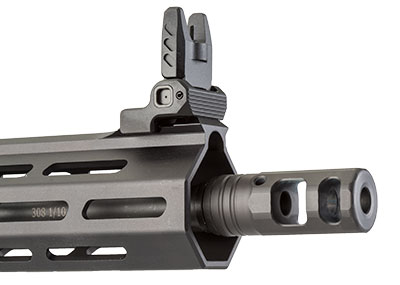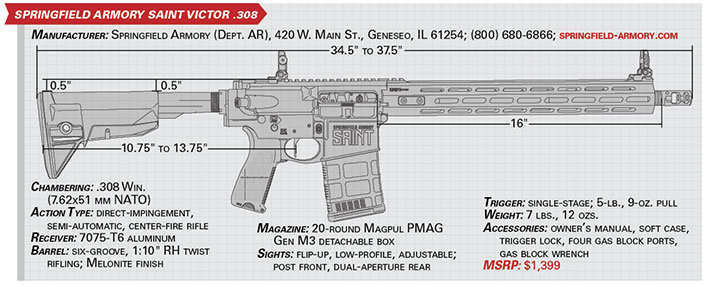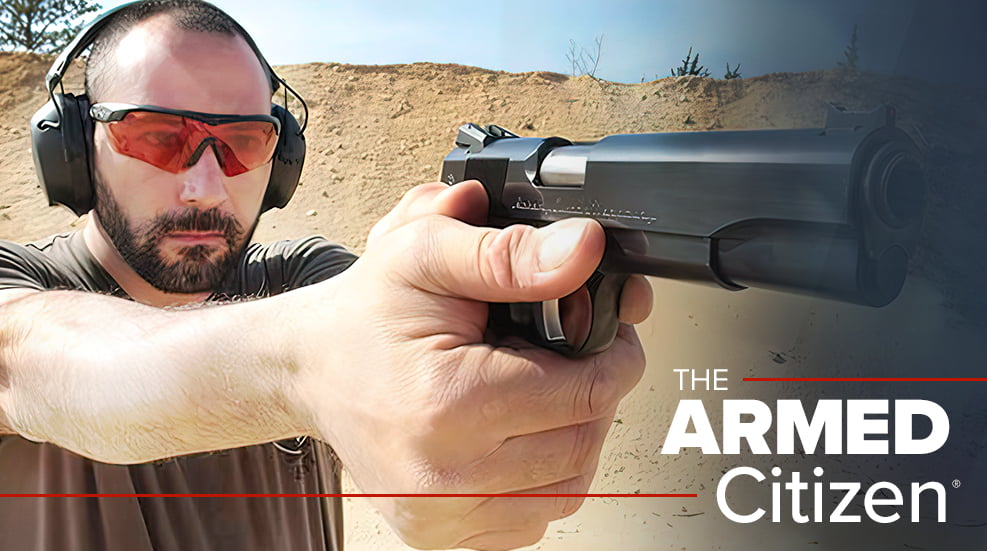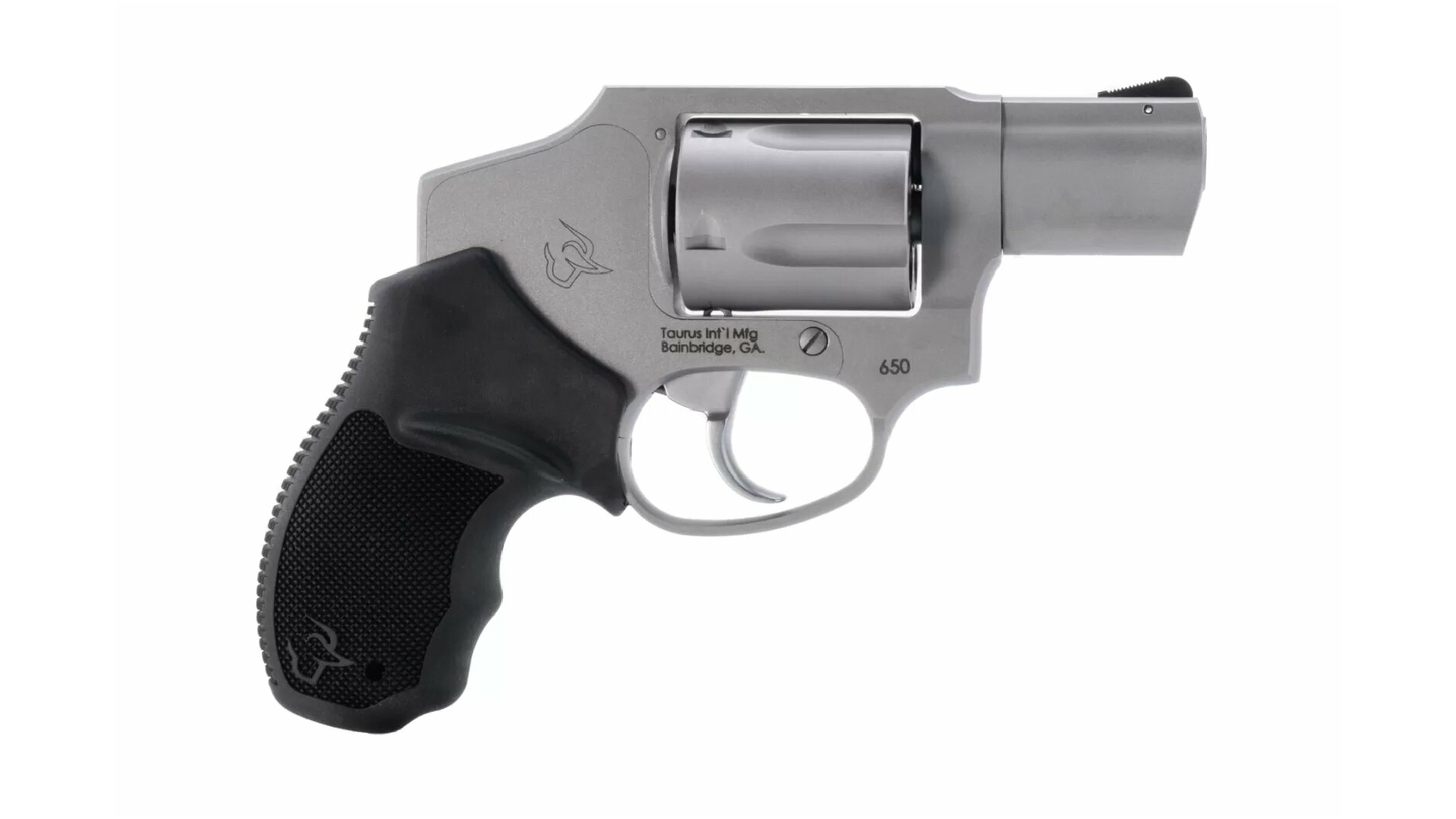
The Saint Victor .308 is topped with a Burris Close Quarter Tactical kit including an RT-8 1-8X 24 mm riflescope and a Fastfire 3 red dot in a P.E.P.R. quick-detach mount. Also shown are a Magpul Bipod with M-Lok attachment and the Magpul PMAG D-50 LR/SR Gen M3 50-round-capacity magazine.
Attempts to turn the clock back to the 7.62x51 mm NATO (.308 Win.) inevitably remind me of the retired general who once told me that if he could just rid the Armed Forces of the ‘Mattel’ rifle, there were 17 different places one could knock out a Soviet T-72 tank with an M14!” So wrote my former boss and friend Technical Editor Bob Hunnicutt in a review of the Knight’s Armament Co. SR-25, entitled “One-Hole Autoloader” (September 1993, p. 46).
The general’s comment, of course, was really an indictment of the 5.56x45 mm NATO cartridge. And though it came nearly two decades into the production of the original semi-automatic M14 clone, Springfield Armory’s M1A, it would now, ironically, apply as well to the company’s newest AR-based rifle: the Saint Victor .308.

M1A Not Going Away
A .308 AR from Springfield? Wait, isn’t this the company founded on the old-school M1A? In Senior Executive Editor Brian Sheetz’s office is a sticker with an M14 silhouette that reads “In 1969 ... This is the only ‘Woodstock’ I Remember.” I am also a card-carrying member of the cult of the M1A. It was the first .308 Win. rifle I ever owned—and the second and third. When it comes to the M1A, I believe.
Today, Springfield makes and sells as many M1As as it is able in myriad configurations. But what if you are not a member of the M1A club? Well, that’s OK, because Springfield now makes a version of its wildly popular AR platform rifle in the same perennial favorite chambering. That gun is the Saint Victor .308—a .308 Win.-chambered version of its AR with upgraded features that, as a package, add up to a real value (see Executive Editor Joe Kurtenbach’s sidebar below). With its Saints, Springfield has found success where others have stumbled; and with the Victor .308, the designers have trimmed out extraneous weight. Sure, there are lighter AR-10-size rifles, but not at this price and with these features.
The Saint’s Bones
The Victor .308 is a direct-impingement, gas-operated semi-automatic with a pinned, low-profile gas block underneath a free-floating 15"-long aluminum handguard. The latter has seven sets of eight slots to accept M-Lok-compatible accessories along its entire length. Attachment to the barrel nut is via two screws on either side—no delta ring here. It measures 1.72" across the flats and does not have a full-length rail at its top. It is the svelte profile of the handguard that takes much of the weight out and makes the Victor handier than many of its competitors. The gas system is adjustable via a set of supplied changeable screws with different apertures that regulate gas flow.
Both the upper and lower receiver are forged 7075-T6 aluminum that are hard-coat-anodized. The lower, which measures 9¼" long from its front to backplate, uses the Accu-Tite tensioning system that takes the slop out of the junction of the upper and lower receivers by means of a nylon-tipped set screw. The .308’s lower receiver is the same as the .223 Rem. Saint’s in width right up to the magazine well. Here it goes from 0.90" wide to 1.42" to accept the wider and longer .308 magazine. The bump out starts behind the bolt release on the left and aft of the magazine release on the right.

The barrel, made in-house, is of chrome-moly-vanadium steel with a lightweight profile that has a Melonite finish both inside and outside. The rifling is six-groove with a 1:10" right-hand twist.
The beefed-up bolt carrier group contains a seven-lug bolt of 9130 steel, with each lug measuring 0.174". Extraction is via a conventional AR extractor, just beefed up, while ejection is powered by a plunger inside the bolt face. The carrier’s rear is untapered without additional rings or lugs and measures 0.930" in diameter. It is backed up by a carbine “H” or heavy tungsten buffer.
The single-stage trigger is Springfield’s own, made in-house with polished micro surfaces, and it is nickel-boron-coated with a flat blade. The sample rifle’s broke at a consistent 5 lbs., 9 ozs., with no discernible take-up and just a little overtravel. I’ve installed aftermarket AR triggers that were not this good.
The magazine release is on the right in front of the trigger, while the bolt catch is on the left. The safety is a 90-degree unit with the lever on the left, but there is an index tab on the pin’s right face indicating its position.
Polymer furniture, as with the rest of the Victors, is from Bravo Company. The buttstock—thankfully with a rubber buttpad—is collapsible with six positions, while the pistol grip is Bravo’s hand-filling Mod.3 with stippling on its sides and grooves on its front.
The Victor .308 comes with a very usable set of spring-loaded back-up iron sights with a windage-adjustable, dual-aperture rear and an elevation-adjustable front post. The rear attaches to the integral Picatinny rail on the receiver’s top—plus two slots in the handguard—while the front mates to an integral 1.21"-long rail section.
The gun comes standard with a muzzle brake designed and manufactured in-house at Springfield with two sets of side vents, one measuring 0.496" long and the other 0.280", with two smaller ports at 2 and 10 o’clock measuring 0.143". It is quite effective in helping keep the sights on target despite the greater energy of the .308 Win. cartridge. That said, on NRA’s indoor test range the vented gas and increased concussive thump on the sidewalls were noticeable. Outside, it was not an issue.

Good Magazine, Better Gun
You can’t have a good gun without a good magazine. For years, the AR-10 platform was a goat rodeo of magazines. Do you use the original Gene Stoner Costa Mesa AR-10 waffle-sided 20-rounder? Or how about a modified FAL magazine? The DPMS magazine? ArmaLite? Or maybe a steel SR-25 magazine? Magpul settled the AR-10 magazine conundrum once and for all when it introduced its PMAG for the U.S. M110 Semi-Automatic Sniper System. As one would expect from Magpul, it is an outstanding magazine, offered in 10-, 20- or 25-round capacities. And there is even the PMAG D-50 LR/SR Gen M3 drum holding 50 rounds. The Victor .308 comes with one 20-round Magpul Gen M3, but I tried them all, including the drum, and they ran without a hitch. As with quite a few other AR-10-style rifles I have evaluated—some far more expensive—surface wear developed on the charging handle and its track on the upper, but didn’t impair function.
Defensive Performance
The Victor .308 is intended as a defensive carbine, while other, longer-barreled versions with thicker-contour barrels will certainly be forthcoming, this first gun is intended for shorter-range work. That SR-25 story by Bob Hunnicutt was written on the cusp of the AR’s ascendancy as America’s rifle; it is the most popular rifle platform for host of reasons. But the M14-loving general had a point. All things being equal, the .308 Win. is superior to the .223 Rem. in terms of energy on target.
Energy matters, and when it comes to the .308 Win. vs. .223 Rem., the former simply has more thanks to its larger-diameter bullet (.308" vs. .223") and greater propellant capacity. Using two loads from Hornady’s American Gunner as an example, a 55-gr. .223 Rem. leaves the muzzle at 3240 f.p.s. out of a 24" test barrel, producing 1,282 ft.-lbs. of energy. A 155-gr. .308 Win. at 2700 f.p.s. delivers 2,509 ft.-lbs. of energy. In case math is not your forte, .308 Win. has nearly double the energy of .223 Rem. in this example.

A defensive rifle must be reliable. In addition to the accuracy testing, the Victor was tested for reliability with bullet weights from 110 to 175 grs. from Black Hills, Federal, Hornady, Nosler, PMC, Remington, SIG and Winchester. Partial boxes I had accumulated from numerous other tests, often mixed in the same magazine—400 rounds in all—ran without a hitch in the gun despite their being a jumbled smorgasbord of headstamps and bullet weights.
The cost for additional downrange energy has been increased recoil and gun weight. I am extremely unlikely to have to take my rifle into a fight with a T-72, but coming in at 7 lbs., 12 ozs., sans magazine, the Saint Victor .308 doesn’t add much weight compared to the first 6-lb., 11-oz. .223 Saint we evaluated (January 2017, p. 48). For less than a pound of extra weight, with increased recoil much diminished by an effective brake, I’ll take that deal. Just don’t tell my M1As.

Saints Alive!
Since engraving its first crossed cannon and flaming bomb insignia onto the forged lower receiver of an AR-style rifle in late 2016, Springfield Armory has not stopped expanding and evolving its catalog of direct-gas, semi-automatic carbines. Any doubt as to whether the firearm market had room for yet another family of black rifles was quickly dispelled, and Springfield’s Saints have become some of the most popular offerings in their class thanks to quality construction, thoughtful feature sets and excellent overall value. In a category often considered saturated, anecdotal evidence and my own observations confirm that the Saints continue to pique the interest of shooters in search of reliable, all-purpose rifles that come ready to run and are backed by an established American manufacturer.
As of this writing, what began as a single, well-appointed platform on the upper end of the entry-level spectrum, has grown to 10 distinct models with dozens of individual SKUs differentiated by firearm type, chambering, color scheme and feature set, including a couple of state-compliant configurations. Saints can be had as standard 16"-barreled carbines, short-barreled rifles (SBR) and as pistol platforms, and cartridge options include not only 5.56x45 mm NATO/.223 Rem., but also .300 Blackout and now, as reviewed nearby, 7.62x51 mm NATO/.308 Win. In order to get a sense of the depth and breadth of this robust and fast-expanding lineup, I think it’s helpful to briefly examine Springfield Armory’s current three-tiered approach to the Saint family and highlight a few of the unique models therein.
Saint
The rifle that started it all was introduced in 5.56 mm NATO with forged receivers, a nickel-boron-coated trigger assembly and a Melonite-treated 16" barrel rifled with the versatile 1:8" twist, all packaged in Bravo Company furniture including a reinforced two-piece handguard with KeyMod accessory attachment ports. Though the original model retains a few vestiges of its M4 roots—including the delta-ring handguard collar and the A2 front sight/gas block/bayonet lug assembly—the Saint line now includes rifles, SBRs and pistols (also available in .300 Blackout) with aluminum free-float handguards that feature M-Lok-compatible cuts and Picatinny rails topside for mounting sights and magnified optics. Prices start at $919 MSRP for the original rifle.

Saint Edge
It’s easy to see Springfield’s legacy of competition shining through in the company’s premium-grade Saint Edge offerings. The firearms in the Edge line have been streamlined for maneuverability and enhanced for performance with no small amount of input along the way from Springfield’s own legendary pro shooter Rob Leatham. Ounces were shaved thanks to a machined billet lower receiver and a lighter-contour barrel, and upgrades include a short-reset, single-stage match trigger, a recoil-mitigating muzzle brake, an easier-to-grasp charging handle, bilateral selector switches and an adjustable gas block to perfectly tune the gun’s operation. Edge platforms are available in rifle, SBR and pistol formats, exclusively in 5.56 mm NATO, and represent the most race-ready AR renditions Springfield has to offer. Consumers will be glad to know that these guns still represent great value, with MSRPs topping out at just $1,559 for the Saint Edge Pistol.

Saint Victor
The most recent branch to grow from the Saint family tree, the Victor line aims to split the difference between the standard Saints and the Edge models in terms of features, weight and price. In my opinion, the Victors also best meet the requirements for true hard-use work guns. As with the other lines, Victors come in rifle, SBR and pistol configurations, and these mid-tier models boast the most options when it comes to chambering—5.56/.223 and 7.62/.308 for the rifles, and 5.56/.223 and .300 Blackout for the pistols. Additional enhancements featured in the Victor platforms include free-float, M-Lok handguards, muzzle brakes, Melonite-treated bolt carrier groups and single-stage, flat-face triggers. Considering their trim design and durable components, and bearing MSRPs that range from $1,015 (pistol) to $1,399 (.308 rifle) the Victor line is well-suited for armed citizens and professionals who run their guns hard, and bet their lives on their performance.
—Joe Kurtenbach, Executive Editor




































